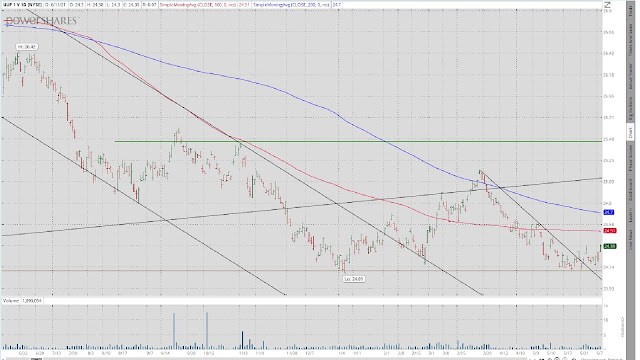The Morning Call
6/14/21
The
Market
Technical
After breaking its
short term uptrend (and resetting to a trading range) in the prior week, the
S&P made a new high last week resetting again to a short term uptrend. Granted it was a tortured effort, but the end
result is still the same. However, given
the index’s slow rate of ascent versus the trendline, it could easily repeat
this process (short term uptrend to trading range back to short term uptrend) in
the coming weeks. If this continues, it is going to be a long boring
summer. That said, it is better than a
400 point drop. Longer term, my premise
remains: ‘I can’t see an end to this uptrend as long as the money keeps flowing
with abundance and in the absence of any major negative exogenous event.’
The big news of
the week was the markets’ wide acceptance of inflation as transitory (at least
for the moment). The long bond’s pin
action captures that fact. After a strong close on the previous Friday,
TLT pushed ahead, negating a very short term trading range and reverting its
100 DMA from resistance to support. This
likely portends further gains to the upside and would be supportive of (1) a lower concern about tapering and (2)
higher stock prices.
https://www.zerohedge.com/markets/what-if-everyone-wrong-about-us-inflations-impact-interest-rates
GLD responded to
the ‘inflation is transitory’ theme as you might expect. With bonds prices falling and the dollar
picking up steam on the notion of disinflation, gold fell. Nonetheless, it remains above both DMA’s and
in uptrends across all timeframes including the move off its March lows. However, if the ‘inflation is transitory’
remains the dominant Market narrative, I would expect further weakness in GLD.
https://www.zerohedge.com/the-market-ear/c1zo00miz5
The dollar continued
its bounce (its fourth) off the lower boundary of the short term trading range,
making a minor new high in the process.
As noted above, its performance reflects the ‘inflation is transitory’
thesis. As long as that dominates investor
psychology, I would expect a further rise in the dollar.
Friday in the
charts.
https://www.zerohedge.com/markets/bond-yields-plunge-most-year-dollar-spikes-inflation-soars
Fundamental
Headlines
The
Economy
Review of Last Week
It was a slow week
for economic releases with no primary indicators reported. What there was, was balanced; though the big
number of the week was May CPI which was higher than expected. I would rate the week as a weak negative which
would extend the string to poor data releases to six weeks. Thus, the stats continue to confirm that the post
Covid burst of economic activity is slowing and supports the notion that the Fed’s
forecast that the current spike in inflation is transitory is right on.
That said, I would
have expected that the aforementioned CPI number to cause some investor consternation;
but I was wrong. Both equity and bond
markets rallied in the face of that datapoint, reaffirming their belief in the
Fed’s ‘transitory’ thesis. So far, so
good.
Transitory or not,
the loss of purchasing power is permanent.
My problem is that
(1) the Fed has never had the right policies in place at critical inflection
points in the economy, (2) nor has it ever successfully executed the transition
from accommodative to normal monetary policy and (3) there are very few investors/economists
around that experienced the ‘too much money chasing too few goods’ type
inflation of the 1970’s.
Bottom line, as I discussed
in Friday’s Morning Call, I think that the biggest risk to the ‘transitory’
scenario is stagflation---slow economic growth accompanied by rising inflation.
http://scottgrannis.blogspot.com/2021/06/the-us-economy-as-seen-from-30000-feet.html
In this piece,
Jeffrey Snider argues that Treasury bonds rates are declining because (1) the Fed
is buying them from the banks, (2) which then have to buy them back [the reverse
repo] to meet reserve requirements. So,
there is constant bid for bonds from the Fed and the banks irrespective of what
is occurring in the economy.
Lance Roberts
argues that rates are falling because they have always dropped near the end of
a monetary easing phase.
https://www.zerohedge.com/markets/talking-taper-fed-starting-campaign-slow-its-asset-purchases
Lance Roberts also
contends that the biggest risk is a much weaker, disinflationary economy with
the Fed either helpless to do anything or becoming too tight and making things
worse.
https://www.zerohedge.com/markets/rates-dollar-feds-dis-inflationary-dilemma
Overseas, the data
flow was again mixed. So, we continue to
get little help on the economic growth front from the rest of globe. One item worth comment is that the ECB
reiterated its support for its QE policy, saying that it may up its bond buying
program. Thus, providing even more ammo
for the ‘too much money chasing too few goods’ argument.
Bottom line. ‘As
you know my opinion is that following an initial snapback (which may already
be over), the US economy will likely return to its former subpar secular growth
rate, stymied by an irresponsible mix of fiscal/monetary policies.’---which are only
getting more irresponsible---with the potential added risk of ‘non-transitory’ inflation.
US
International
April
EU industrial production rose 0.8% versus consensus of +0.4%.
Other
News on Stocks in Our Portfolios
What
I am reading today
Visit Investing for Survival’s
website (http://investingforsurvival.com/home)
to learn more about our Investment Strategy, Prices Disciplines and Subscriber
Service.





No comments:
Post a Comment